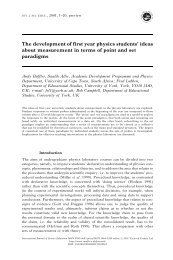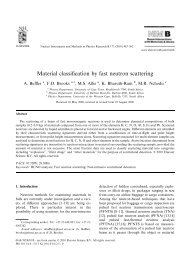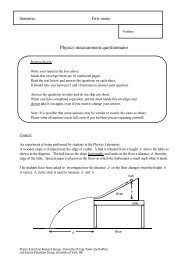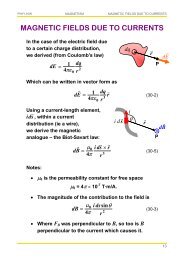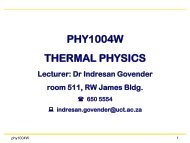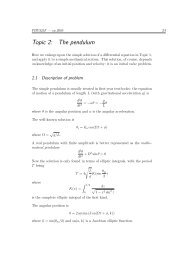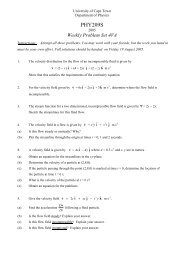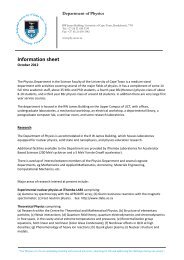Flux and Gauss' Law
Flux and Gauss' Law
Flux and Gauss' Law
Create successful ePaper yourself
Turn your PDF publications into a flip-book with our unique Google optimized e-Paper software.
PHY110W ELECTRICITY SUPPLEMENTARY GAUSS’ LAW<br />
Types of questions<br />
Questions on this section usually fall into one of three categories:<br />
1. Calculating the flux through some given surface (maybe part of a bigger, complete, Gaussian surface).<br />
[This type of question is a bit artificial <strong>and</strong> is really just for practice.]<br />
2. Working with the net flux through an entire Gaussian surface <strong>and</strong> applying Gauss’ <strong>Law</strong> to find the<br />
enclosed charge (or vice versa).<br />
3. Using the principle of Gauss’ <strong>Law</strong> to determine the electric field due to some distribution of charge.<br />
[Which is the main purpose of this section – determining electric fields – so that we can easily determine<br />
the force on a charged particle, <strong>and</strong> from here the amount of work done in moving it, etc etc.]<br />
Examples:<br />
* * * * *<br />
Type 1. A cubic Gaussian surface is bounded by the planes at x = 0.40 m,<br />
y = 0.60 m <strong>and</strong> z = 0.40 m as shown in the sketch. The electric field in this<br />
region is non-uniform <strong>and</strong> is given by E = (2.00 + 3.00x 2 )î N/C. Calculate<br />
the flux through the right h<strong>and</strong> face (ie the shaded face) of the cube.<br />
<br />
Solution: Φ= ∫ E ⋅dA<br />
Over the whole shaded surface x = 0.40 m, so the electric field is a<br />
constant (2.00 + 3.00 × 0.40 2 ) = 2.48 N/C <strong>and</strong> lies in the positive x<br />
direction, ie parallel to the area vector, so cosθ = 1, <strong>and</strong> we get<br />
0.6<br />
0.2<br />
y<br />
z 0.4<br />
0.4<br />
Φ<br />
right<br />
= E∫ dA = E A = 2.48 × 0.40 2 = 0,397 N⋅m 2 /C<br />
[Strictly speaking, you should evaluate the dot product more formally using unit vectors.]<br />
x<br />
3



